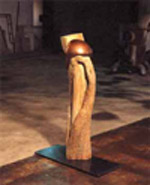

|
| Critic | |
|
| |
|
Critic Kang, Joon-ho's work made in broken oak trees. The work stands tall
with the power of size and weight beyond his remarks of resisting the
cords of life. Rather, the works possess pride of themselves in showing
the cracks of fall down as if they had much enjoyed tough blast of earth.
They do exist daring non-fit. From the creepy roaring of the gaps in the oak, to the straight forth
aggression of splitting themselves without bending down, his chords on
oaks vary wide. The four parts of the oak lump in a hold fast aside define
the meaning of self as an obsession in candid manner. In the other, it
starts from the primary side cutting of lumber and ends off with the sanding
out of the inner planes. They all just exist without proclaiming geometrical
symmetry nor even surface in the pieces. Yet, the plainness occupies much
more than ever. As if a window enables opening in ritual passage of sharing
breath whereas a mirror simply tosses light out, vacuums mean neither
fears nor wants any longer. Kang, Joon-ho's great concerns on his own ego reveal those unacceptable
natures of untamed energy which has to be controlled unless casting out
from the circle of civils. From the moment he got the nostalgia of the
bare origin facing the peeping Tom cults and sensualisms of the nowadays
art without screen, he might have been missing his own emancipated world.
Works for work, life is for life, I say. Yet, he regards his work as a
reflection and projection of ego. At least, he might be expecting his
own resemblance from the enduring stands of the trees still holding their
innate parts intact, the shining examples of the tough force living creatures. In fact, the touch and variances of the forms are following the guidance
of touch nature of the tree. Petting, tipping and sometimes cutting the
unyielding lump without a hesitation, he finds out abstract meaning: the
metaphoric harmony between man and nature. There, as he restores the image
of the matter to scatter the viewers' paradigm of thought, his taken role
goes beyond an artisan and become a conductor. The matters presented as
the proof of thought, bordered by the days of routine mark in wild nature,
mostly assimilated with the recollections of the passage in real world,
intervenes his life consisting of real frames in time. He also displays partial bronze casting for the more rich decoration
of the chord in the works defining the border of his world against the
self-reflection and the dialogues on it. It is the character of those
bronze beings that uncertainty expelled from the nature. His collection
in oak trees once dominated on their spots as the heirs of earth and rain.
They are remnants of lives, while his fabrication oft them symbolize the
bitter sweet memoirs of his personal life. Their forms dualize the will
of life force and the suffering in visual breakup with the rough texture
of the trees showing the traces of growths, the vernal pleasures and the
signatures of harsh sunrays and blast of many Winters. Meanwhile, this
significant dualism is a result of numerous experiments with unity and
contrast in plastic context of the works. Structuring reversal repetition
of the form, the contrast in matters emphasizes the dualism, between the
methodical adaptation to convert the cords of life into the unleashed
self-consciousness and the versatility of the thought in the barren substantialities.
The coalition of the double structure of segment with the female fertilities
directs a cycle of repetition as a hermaphroditic existence. The chordal
allocations of the space in the matters, functional adjusting of the bronze
images, and contrasting inner plane with the rough skin of the lumps,
seemingly all reconstruct the repetitive everyday life in visual context.
Developing the descriptive steps to customize the knowledge of form, he
chooses combination and bypass, which, more likely than not, shows the
structures weighing on itself to sustain their monumentality. The suggestion
in the serial works of 'the Opening of Ego' is the passage of transforming
the established upright into a different medium. Their male-centered and authoritative character, with the upright standing
in structure, amplify the bronze image to a plausible motif. In that his
representative forms derived from the contemplative purpose, his Work
are mainly concentrated in the process of tuning the gestures, and grasps
of revealed form. The relations in the mass with attached parts and the
revealed inside glimpse a kind of coexistence or harmony. After all, he
wants to say that the will of life to stand and project is just a counterpart
of the gravity, which consists of the rules and ethics in oppressive control. Relatively, toughness can be a strategy to endure the pressure of oppression.
'The projection of life' series show the two different structures of state
distorted in pressure and momentum reality in a body. Yet, the structure
does not follow any constructional rules. Instead of harmonic, balanced
stance, the new principle of proliferation suppressed deep down in control
comes out as an alternative solution. The Mother nature as an allegory
of the cycle of life has been too much familiar already. We are just not
accustomed to frankness yet. The more civilized as we are, the harder
we learn the lesson: frankness is not something like born freedom of nakedness
but ignorant shame of unkind directness. And I do believe the world become
healthier than ever if we learn such kindness in that he has found the
vocabulary of desire hidden inside himself while caring those forms in
wild. |